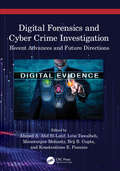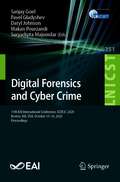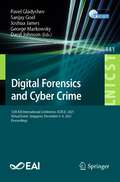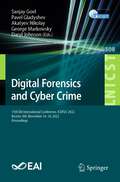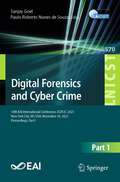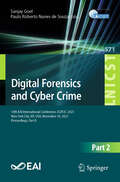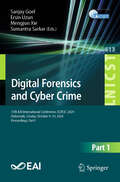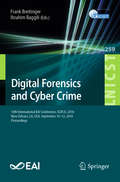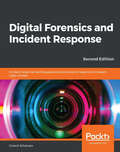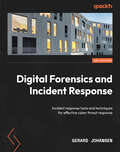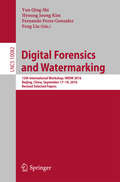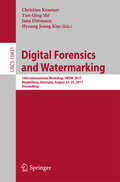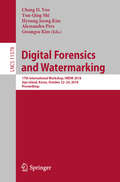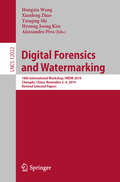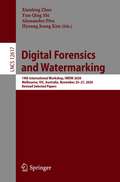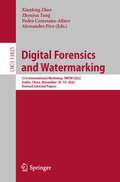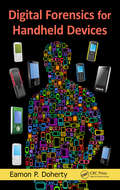- Table View
- List View
Digital Forensics and Cyber Crime Investigation: Recent Advances and Future Directions
by Manoranjan Mohanty Brij B. Gupta Lo’ai Tawalbeh Ahmed A. Abd El-Latif Konstantinos E. PsannisIn the ever-evolving landscape of digital forensics and cybercrime investigation, staying ahead with the latest advancements is not just advantageous—it’s imperative. Digital Forensics and Cyber Crime Investigation: Recent Advances and Future Directions serves as a crucial bridge, connecting the dots between the present knowledge base and the fast-paced developments in this dynamic field. Through a collection of meticulous research and expert insights, this book dissects various facets of digital forensics and cyber security, providing readers with a comprehensive look at current trends and future possibilities. Distinguished by its in-depth analysis and forward-looking perspective, this volume sets itself apart as an indispensable resource for those keen on navigating the complexities of securing the digital domain. Key features of this book include: Innovative Strategies for Web Application Security: Insights into Moving Target Defense (MTD) techniques Blockchain Applications in Smart Cities: An examination of how blockchain technology can fortify data security and trust Latest Developments in Digital Forensics: A thorough overview of cutting-edge techniques and methodologies Advancements in Intrusion Detection: The role of Convolutional Neural Networks (CNN) in enhancing network security Augmented Reality in Crime Scene Investigations: How AR technology is transforming forensic science Emerging Techniques for Data Protection: From chaotic watermarking in multimedia to deep learning models for forgery detection This book aims to serve as a beacon for practitioners, researchers, and students who are navigating the intricate world of digital forensics and cyber security. By offering a blend of recent advancements and speculative future directions, it not only enriches the reader’s understanding of the subject matter but also inspires innovative thinking and applications in the field. Whether you’re a seasoned investigator, an academic, or a technology enthusiast, Digital Forensics and Cyber Crime Investigation: Recent Advances and Future Directions promises to be a valuable addition to your collection, pushing the boundaries of what’s possible in digital forensics and beyond.
Digital Forensics and Cyber Crime: 11th EAI International Conference, ICDF2C 2020, Boston, MA, USA, October 15-16, 2020, Proceedings (Lecture Notes of the Institute for Computer Sciences, Social Informatics and Telecommunications Engineering #351)
by Sanjay Goel Pavel Gladyshev Daryl Johnson Suryadipta Majumdar Makan PourzandiThis book constitutes the refereed proceedings of the 11th International Conference on Digital Forensics and Cyber Crime, ICDF2C 2020, held in Boston, MA, in October 2020. Due to COVID-19 pandemic the conference was held virtually. The 11 reviewed full papers and 4 short papers were selected from 35 submissions and are grouped in topical sections on digital forensics; cyber-physical system Forensics; event reconstruction in digital forensics; emerging topics in forensics; cybersecurity and digital forensics.
Digital Forensics and Cyber Crime: 12th EAI International Conference, ICDF2C 2021, Virtual Event, Singapore, December 6-9, 2021, Proceedings (Lecture Notes of the Institute for Computer Sciences, Social Informatics and Telecommunications Engineering #441)
by Sanjay Goel Pavel Gladyshev Daryl Johnson Joshua James George MarkowskyThis book constitutes the refereed proceedings of the 12th International Conference on Digital Forensics and Cyber Crime, ICDF2C 2021, held in Singapore in December 2021. Due to COVID-19 pandemic the conference was held virtually.The 22 reviewed full papers were selected from 52 submissions and present digital forensic technologies and techniques for a variety of applications in criminal investigations, incident response and information security. The focus of ICDS2C 2021 was on various applications and digital evidence and forensics beyond traditional cybercrime investigations and litigation.
Digital Forensics and Cyber Crime: 13th EAI International Conference, ICDF2C 2022, Boston, MA, November 16-18, 2022, Proceedings (Lecture Notes of the Institute for Computer Sciences, Social Informatics and Telecommunications Engineering #508)
by Sanjay Goel Pavel Gladyshev Daryl Johnson George Markowsky Akatyev NikolayThis book constitutes the refereed proceedings of the 13th EAI International Conference on Practical Aspects of Digital Forensics and Cyber Crime, ICDF2C 2022, held in Boston, MA, during November 16-18, 2022.The 28 full papers included in this book were carefully reviewed and selected from 80 submissions. They were organized in topical sections as follows: Image Forensics; Forensics Analysis; spread spectrum analysis; traffic analysis and monitoring; malware analysis; security risk management; privacy and security.
Digital Forensics and Cyber Crime: 14th EAI International Conference, ICDF2C 2023, New York City, NY, USA, November 30, 2023, Proceedings, Part I (Lecture Notes of the Institute for Computer Sciences, Social Informatics and Telecommunications Engineering #570)
by Sanjay Goel Paulo Roberto Nunes de SouzaThe two-volume set LNICST 570 and 571 constitutes the refereed post-conference proceedings of the 14th EAI International Conference on Digital Forensics and Cyber Crime, ICDF2C 2023, held in New York City, NY, USA, during November 30, 2023.The 41 revised full papers presented in these proceedings were carefully reviewed and selected from 105 submissions. The papers are organized in the following topical sections:Volume I:Crime profile analysis and Fact checking, Information hiding and Machine learning.Volume II: Password, Authentication and Cryptography, Vulnerabilities and Cybersecurity and forensics.
Digital Forensics and Cyber Crime: 14th EAI International Conference, ICDF2C 2023, New York City, NY, USA, November 30, 2023, Proceedings, Part II (Lecture Notes of the Institute for Computer Sciences, Social Informatics and Telecommunications Engineering #571)
by Sanjay Goel Paulo Roberto Nunes de SouzaThe two-volume set LNICST 570 and 571 constitutes the refereed post-conference proceedings of the 14th EAI International Conference on Digital Forensics and Cyber Crime, ICDF2C 2023, held in New York City, NY, USA, during November 30, 2023.The 41 revised full papers presented in these proceedings were carefully reviewed and selected from 105 submissions. The papers are organized in the following topical sections:Volume I:Crime profile analysis and Fact checking, Information hiding and Machine learning.Volume II: Password, Authentication and Cryptography, Vulnerabilities and Cybersecurity and forensics.
Digital Forensics and Cyber Crime: 15th EAI International Conference, ICDF2C 2024, Dubrovnik, Croatia, October 9–10, 2024, Proceedings, Part I (Lecture Notes of the Institute for Computer Sciences, Social Informatics and Telecommunications Engineering #613)
by Sanjay Goel Ersin Uzun Mengjun Xie Sumantra SarkarThe two-volume set, LNICST 613 and 614, constitutes the refereed post-conference proceedings of the 15th EAI International Conference on Digital Forensics and Cyber Crime, ICDF2C 2024, held in Dubrovnik, Croatia, during October 9–10, 2024. The 40 full papers presented here were carefully selected and reviewed from 90 submissions. These papers have been organized in the following topical sections: Part I- Artificial Intelligence & Security; Multimedia Forensics; Intrusion Detection; Intrusion and Fraud Detection; Large Language Models, Advances in Security and Forensics; Advances in Security and Forensics. Part II- Security Analytics, Threat Intelligence, Multimedia Forensics; Generative AI, Emerging Threats.
Digital Forensics and Cyber Crime: 15th EAI International Conference, ICDF2C 2024, Dubrovnik, Croatia, October 9–10, 2024, Proceedings, Part II (Lecture Notes of the Institute for Computer Sciences, Social Informatics and Telecommunications Engineering #614)
by Sanjay Goel Ersin Uzun Mengjun Xie Sumantra SarkarThe two-volume set, LNICST 613 and 614, constitutes the refereed post-conference proceedings of the 15th EAI International Conference on Digital Forensics and Cyber Crime, ICDF2C 2024, held in Dubrovnik, Croatia, during October 9–10, 2024. The 40 full papers presented here were carefully selected and reviewed from 90 submissions. These papers have been organized in the following topical sections: Part I- Artificial Intelligence & Security; Multimedia Forensics; Intrusion Detection; Intrusion and Fraud Detection; Large Language Models, Advances in Security and Forensics; Advances in Security and Forensics. Part II- Security Analytics, Threat Intelligence, Multimedia Forensics; Generative AI, Emerging Threats.
Digital Forensics and Cyber Crime: 7th International Conference, Icdf2c 2015, Seoul, South Korea, October 6-8, 2015. Revised Selected Papers (Lecture Notes of the Institute for Computer Sciences, Social Informatics and Telecommunications Engineering #259)
by Ibrahim Baggili Frank BreitingerThis book constitutes the refereed proceedings of the 10th International Conference on Digital Forensics and Cyber Crime, ICDF2C 2018, held in New Orleans, LA, USA, in September 2018. The 11 reviewed full papers and 1 short paper were selected from 33 submissions and are grouped in topical sections on carving and data hiding, android, forensic readiness, hard drives and digital forensics, artifact correlation.
Digital Forensics and Incident Response
by Gerard JohansenThis book is targeted at Information Security professionals, forensics practitioners, and students with knowledge and experience in the use of software applications and basic command-line experience. It will also help professionals who are new to the incident response/digital forensics role within their organization.
Digital Forensics and Incident Response: Incident response techniques and procedures to respond to modern cyber threats
by Gerard JohansenBuild your organization's cyber defense system by effectively implementing digital forensics and incident management techniquesKey FeaturesCreate a solid incident response framework and manage cyber incidents effectivelyPerform malware analysis for effective incident responseExplore real-life scenarios that effectively use threat intelligence and modeling techniquesBook DescriptionAn understanding of how digital forensics integrates with the overall response to cybersecurity incidents is key to securing your organization's infrastructure from attacks. This updated second edition will help you perform cutting-edge digital forensic activities and incident response. After focusing on the fundamentals of incident response that are critical to any information security team, you’ll move on to exploring the incident response framework. From understanding its importance to creating a swift and effective response to security incidents, the book will guide you with the help of useful examples. You’ll later get up to speed with digital forensic techniques, from acquiring evidence and examining volatile memory through to hard drive examination and network-based evidence. As you progress, you’ll discover the role that threat intelligence plays in the incident response process. You’ll also learn how to prepare an incident response report that documents the findings of your analysis. Finally, in addition to various incident response activities, the book will address malware analysis, and demonstrate how you can proactively use your digital forensic skills in threat hunting. By the end of this book, you’ll have learned how to efficiently investigate and report unwanted security breaches and incidents in your organization.What you will learnCreate and deploy an incident response capability within your own organizationPerform proper evidence acquisition and handlingAnalyze the evidence collected and determine the root cause of a security incidentBecome well-versed with memory and log analysisIntegrate digital forensic techniques and procedures into the overall incident response processUnderstand the different techniques for threat huntingWrite effective incident reports that document the key findings of your analysisWho this book is forThis book is for cybersecurity and information security professionals who want to implement digital forensics and incident response in their organization. You will also find the book helpful if you are new to the concept of digital forensics and are looking to get started with the fundamentals. A basic understanding of operating systems and some knowledge of networking fundamentals are required to get started with this book.
Digital Forensics and Incident Response: Incident response techniques and procedures to respond to modern cyber threats, 2nd Edition
by Gerard JohansenBuild your organization's cyber defense system by effectively implementing digital forensics and incident management techniquesKey FeaturesCreate a solid incident response framework and manage cyber incidents effectivelyPerform malware analysis for effective incident responseExplore real-life scenarios that effectively use threat intelligence and modeling techniquesBook DescriptionAn understanding of how digital forensics integrates with the overall response to cybersecurity incidents is key to securing your organization's infrastructure from attacks. This updated second edition will help you perform cutting-edge digital forensic activities and incident response.After focusing on the fundamentals of incident response that are critical to any information security team, you'll move on to exploring the incident response framework. From understanding its importance to creating a swift and effective response to security incidents, the book will guide you with the help of useful examples. You'll later get up to speed with digital forensic techniques, from acquiring evidence and examining volatile memory through to hard drive examination and network-based evidence. As you progress, you'll discover the role that threat intelligence plays in the incident response process. You'll also learn how to prepare an incident response report that documents the findings of your analysis. Finally, in addition to various incident response activities, the book will address malware analysis, and demonstrate how you can proactively use your digital forensic skills in threat hunting.By the end of this book, you'll have learned how to efficiently investigate and report unwanted security breaches and incidents in your organization.What you will learnCreate and deploy an incident response capability within your own organizationPerform proper evidence acquisition and handlingAnalyze the evidence collected and determine the root cause of a security incidentBecome well-versed with memory and log analysisIntegrate digital forensic techniques and procedures into the overall incident response processUnderstand the different techniques for threat huntingWrite effective incident reports that document the key findings of your analysisWho this book is forThis book is for cybersecurity and information security professionals who want to implement digital forensics and incident response in their organization. You will also find the book helpful if you are new to the concept of digital forensics and are looking to get started with the fundamentals. A basic understanding of operating systems and some knowledge of networking fundamentals are required to get started with this book.
Digital Forensics and Incident Response: Incident response tools and techniques for effective cyber threat response, 3rd Edition
by Gerard JohansenBuild your organization's cyber defense system by effectively applying digital forensics, incident management, and investigation techniques to real-world cyber threatsKey FeaturesCreate a solid incident response framework and manage cyber incidents effectivelyLearn to apply digital forensics tools and techniques to investigate cyber threatsExplore the real-world threat of ransomware and apply proper incident response techniques for investigation and recoveryBook DescriptionAn understanding of how digital forensics integrates with the overall response to cybersecurity incidents is key to securing your organization's infrastructure from attacks. This updated third edition will help you perform cutting-edge digital forensic activities and incident response with a new focus on responding to ransomware attacks.After covering the fundamentals of incident response that are critical to any information security team, you'll explore incident response frameworks. From understanding their importance to creating a swift and effective response to security incidents, the book will guide you using examples. Later, you'll cover digital forensic techniques, from acquiring evidence and examining volatile memory through to hard drive examination and network-based evidence. You'll be able to apply these techniques to the current threat of ransomware. As you progress, you'll discover the role that threat intelligence plays in the incident response process. You'll also learn how to prepare an incident response report that documents the findings of your analysis. Finally, in addition to various incident response activities, the book will address malware analysis and demonstrate how you can proactively use your digital forensic skills in threat hunting.By the end of this book, you'll be able to investigate and report unwanted security breaches and incidents in your organization.What you will learnCreate and deploy an incident response capability within your own organizationPerform proper evidence acquisition and handlingAnalyze the evidence collected and determine the root cause of a security incidentIntegrate digital forensic techniques and procedures into the overall incident response processUnderstand different techniques for threat huntingWrite incident reports that document the key findings of your analysisApply incident response practices to ransomware attacksLeverage cyber threat intelligence to augment digital forensics findingsWho this book is forThis book is for cybersecurity and information security professionals who want to implement digital forensics and incident response in their organizations. You'll also find the book helpful if you're new to the concept of digital forensics and looking to get started with the fundamentals. A basic understanding of operating systems and some knowledge of networking fundamentals are required to get started with this book.
Digital Forensics and Internet of Things: Impact and Challenges
by Rajesh Singh Anita Gehlot Neeta Raj Sharma Jaskaran SinghDIGITAL FORENSICS AND INTERNET OF THINGS It pays to be ahead of the criminal, and this book helps organizations and people to create a path to achieve this goal. The book discusses applications and challenges professionals encounter in the burgeoning field of IoT forensics. IoT forensics attempts to align its workflow to that of any forensics practice—investigators identify, interpret, preserve, analyze and present any relevant data. As with any investigation, a timeline is constructed, and, with the aid of smart devices providing data, investigators might be able to capture much more specific data points than in a traditional crime. However, collecting this data can often be a challenge, as it frequently doesn’t live on the device itself, but rather in the provider’s cloud platform. If you can get the data off the device, you’ll have to employ one of a variety of methods given the diverse nature of IoT devices hardware, software, and firmware. So, while robust and insightful data is available, acquiring it is no small undertaking. Digital Forensics and Internet of Things encompasses: State-of-the-art research and standards concerning IoT forensics and traditional digital forensics Compares and contrasts IoT forensic techniques with those of traditional digital forensics standards Identifies the driving factors of the slow maturation of IoT forensic standards and possible solutions Applies recommended standards gathered from IoT forensic literature in hands-on experiments to test their effectiveness across multiple IoT devices Provides educated recommendations on developing and establishing IoT forensic standards, research, and areas that merit further study. Audience Researchers and scientists in forensic sciences, computer sciences, electronics engineering, embedded systems, information technology.
Digital Forensics and Watermarking
by Feng Liu Hyoung Joong Kim Yun Qing Shi Fernando Perez-GonzalezThis book constitutes revised selected papers from the 14th International Workshop on Digital-Forensics and Watermarking, IWDW 2015, held in Tokyo, Japan, in October 2015. The 35 papers presented in this volume were carefully reviewed and selected from 54 submissions. The contributions are organized in topical sections named: digital forensics; steganography and steganalysis; digital watermarking; reversible data hiding; and visual cryptography.
Digital Forensics and Watermarking: 15th International Workshop, IWDW 2016, Beijing, China, September 17-19, 2016, Revised Selected Papers (Lecture Notes in Computer Science #10082)
by Yun Qing Shi, Hyoung Joong Kim, Fernando Perez-Gonzalez and Feng LiuThis book constitutes the revised post-conference proceedings of the 15th International Workshop on Digital Forensics and Watermarking, IWDW 2016, held in Beijing, China, in September 2016.The 45 papers presented in this volume were carefully reviewed and selected from 70 submissions. The contributions are organized in topical sections on digital forensics, visual cryptography, reversible data hiding, and steganography and steganalysis.
Digital Forensics and Watermarking: 16th International Workshop , IWDW 2017, Magdeburg, Germany, August 23-25, 2017, Proceedings (Lecture Notes in Computer Science #10431)
by Christian Kraetzer, Yun-Qing Shi, Jana Dittmann and Hyoung Joong KimThis book constitutes the refereed proceedings of the 16th International Workshop on Digital Forensics and Watermarking, IWDW 2017, held in Magdeburg, Germany, in August 2017. The 30 papers presented in this volume were carefully reviewed and selected from 48 submissions. The contributions are covering the state-of-the-art theoretical and practical developments in the fields of digital watermarking, steganography and steganalysis, forensics and anti-forensics, visual cryptography, and other multimedia-related security issues. Also included are the papers on two special sessions on biometric image tampering detection and on emerging threats of criminal use of information hiding : usage scenarios and detection approaches.
Digital Forensics and Watermarking: 17th International Workshop, IWDW 2018, Jeju Island, Korea, October 22-24, 2018, Proceedings (Lecture Notes in Computer Science #11378)
by Yun-Qing Shi Hyoung Joong Kim Alessandro Piva Chang D. Yoo Gwangsu KimThis book constitutes the refereed proceedings of the 17th International Workshop on Digital Forensics and Watermarking, IWDW 2018, held on Jeju Island, Korea, in October 2018.The 25 papers presented in this volume were carefully reviewed and selected from 43 submissions. The contributions are covering the following topics: deep neural networks for digital forensics; steganalysis and identification; watermarking; reversible data hiding; steganographic algorithms; identification and security; deep generative models for forgery and its detection.
Digital Forensics and Watermarking: 18th International Workshop, IWDW 2019, Chengdu, China, November 2–4, 2019, Revised Selected Papers (Lecture Notes in Computer Science #12022)
by Hyoung Joong Kim Alessandro Piva Hongxia Wang Xianfeng Zhao Yunqing ShiThe 22 full papers and 12 shorts papers presented in this volume were carefully reviewed and selected from 70 submissions. The contributions are covering the following topics: deep learning for multimedia security; digital forensics and anti-forensics; digital watermarking; information hiding; steganography and steganalysis; authentication and security.
Digital Forensics and Watermarking: 19th International Workshop, IWDW 2020, Melbourne, VIC, Australia, November 25–27, 2020, Revised Selected Papers (Lecture Notes in Computer Science #12617)
by Yun-Qing Shi Hyoung Joong Kim Alessandro Piva Xianfeng ZhaoThis volume constitutes the proceedings of the 19th International Workshop on Digital Forensics and Watermarking, IWDW 2020, held in Melbourne, VIC, Australia, in November 2020.The 20 full papers in this volume were carefully reviewed and selected from 43 submissions. They cover topics such as: novel research, development and application of digital watermarking and forensics techniques for multimedia security.
Digital Forensics and Watermarking: 20th International Workshop, IWDW 2021, Beijing, China, November 20–22, 2021, Revised Selected Papers (Lecture Notes in Computer Science #13180)
by Alessandro Piva Xianfeng Zhao Pedro Comesaña-AlfaroThis volume constitutes the proceedings of the 20th International Workshop on Digital Forensics and Watermarking, IWDW 2021, held in Beijing, China, in November 2021. The 18 full papers in this volume were carefully reviewed and selected from 32 submissions. The are categorized in the following topical headings: Forensics and Security Analysis; Watermarking and Steganology.
Digital Forensics and Watermarking: 21st International Workshop, IWDW 2022, Guilin, China, November 18-19, 2022, Revised Selected Papers (Lecture Notes in Computer Science #13825)
by Alessandro Piva Xianfeng Zhao Pedro Comesaña-Alfaro Zhenjun TangThis book constitutes the refereed proceedings of the 21st International Workshop, IWDW 2022, held in Guilin, China, during November 18-19, 2022. The 14 full papers included in this book were carefully reviewed and selected from 30 submissions. They were organized in topical sections as follows: Steganology, Forensics and Security Analysis, Watermarking.
Digital Forensics and Watermarking: 22nd International Workshop, IWDW 2023, Jinan, China, November 25–26, 2023, Revised Selected Papers (Lecture Notes in Computer Science #14511)
by Qi Li Jian Li Bin MaThis book constitutes the refereed post proceedings of the 22nd International Workshop on Digital Forensics and Watermarking, IWDW 2023, held in Jinan, China, during November 25–26, 2023. The 22 full papers included in this book were carefully reviewed and selected from 48 submissions. The workshop focuses on subjects such as novel research, development and application of digital watermarking, data hiding, and forensic techniques for multimedia security.
Digital Forensics for Handheld Devices
by Eamon P. DohertyApproximately 80 percent of the worlds population now owns a cell phone, which can hold evidence or contain logs about communications concerning a crime. Cameras, PDAs, and GPS devices can also contain information related to corporate policy infractions and crimes. Aimed to prepare investigators in the public and private sectors, Digital Forensics
Digital Forensics in Next-Generation Internet of Medical Things: Balancing Security and Sustainability
by Mariya Ouaissa Mariyam Ouaissa Sita Rani Hemant Kumar Saini Hajar Moudoud El Houda, Zakaria AbouThis book provides a comprehensive exploration of the security challenges and solutions with digital sustainability in the rapidly evolving digital landscape of digital forensics. It explores the details of protecting Internet of Medical Things (IoMT) environments, where the medical data, patient data, and machine data are at high risk with the digital experiences. The book seeks to provide researchers, medical practitioners, and IT specialists with important information. It aims to set the stage for a future in which security and efficiency in IoMT smoothly blend through real-world case studies. Key themes cover IoMT-specific forensic techniques, the difficulties of striking a balance between environmental responsibility and security, and creative solutions that combine the two viewpoints.
